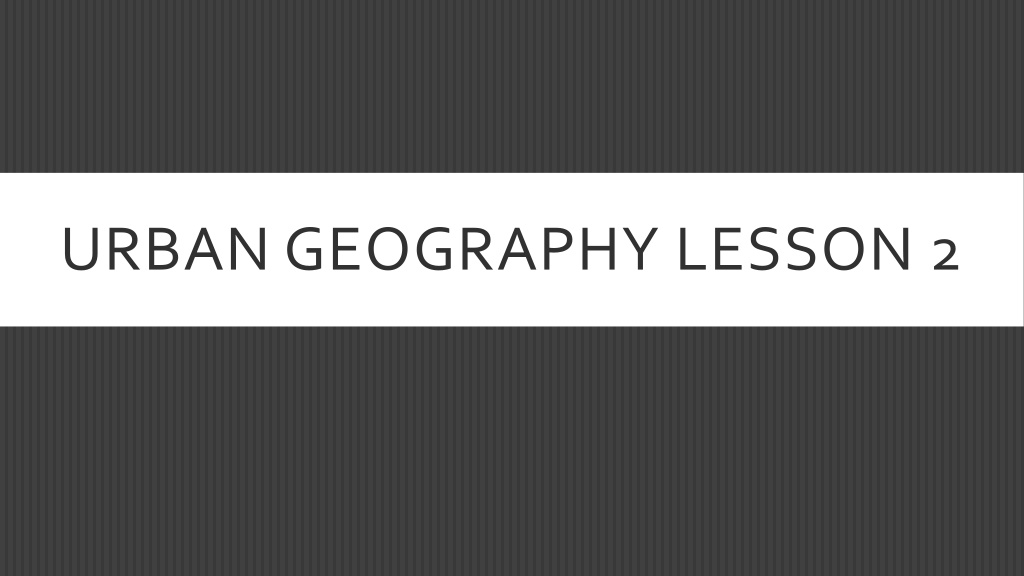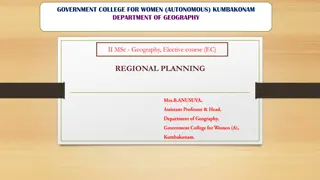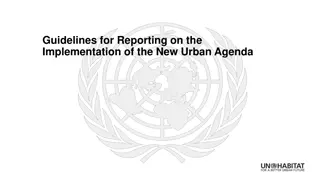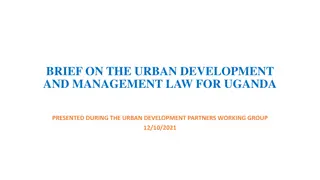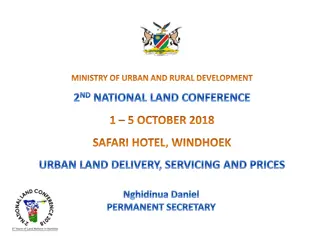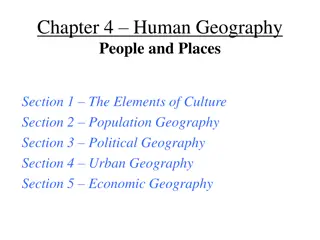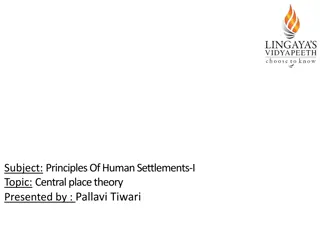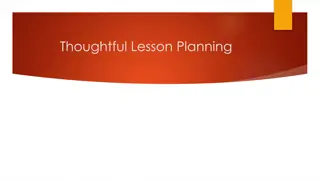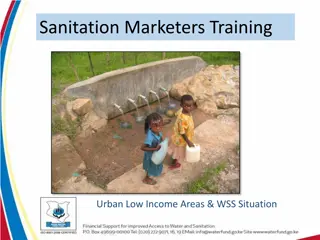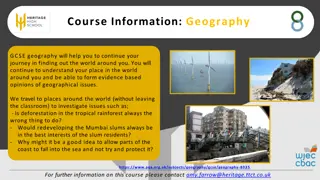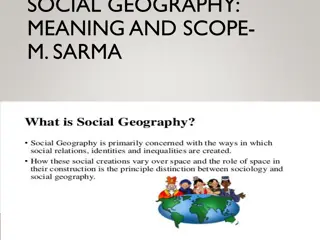Understanding Central Place Theory in Urban Geography Lesson
Explore the concepts of Central Place Theory, Range, Threshold, Businesses' application of these theories, and the significance of Hinterland in urban geography. Learn how these theories help businesses determine their potential success based on customer distance and behavior.
Download Presentation

Please find below an Image/Link to download the presentation.
The content on the website is provided AS IS for your information and personal use only. It may not be sold, licensed, or shared on other websites without obtaining consent from the author. Download presentation by click this link. If you encounter any issues during the download, it is possible that the publisher has removed the file from their server.
E N D
Presentation Transcript
THE STUDENT WILL BE ABLE TO DISCUSS How central place theory works. Today s PowerPoint borrowed heavily from:
CENTRAL PLACE THEORY Kind of a big deal. Walter Christaller 1933 study of South Germany Assumes flat, homogeneous surface, an evenly distributed population, and equidistant patterns. Evenly distributed resources and that people will only travel nearest distance for what is desired Shows relationship between urban areas Includes hinterlands & range cities need to maintain size I m a big deal.
RANGE & THRESHOLD Range is the maximum distance that people are willing to travel to purchase a product or partake in a service; it may vary depending upon the product. You want a soda; how far are you willing to go for it? Typically no more than a mile or so; it is a low cost item and commonly available People go to the closest store for a soda
BUSINESSES STILL USE THIS THEORY Business Owners find out the threshold for their business pre-opening How many water beds do I need to sale to be profitable? The range is also good to try and figure out, but most wait until after they are opened. Businesses use census tracts to determine potential business When advertising commercial property it is usually included (Next slide)
HINTERLAND Sometimes called market area It is the area in which a product, urban area, or commercial out has influence (See next slide) The area that they are drawing from
THRESHOLD Thresholdapplies to the product; it s the minimum number of customers needed for it to succeed. Threshold for a bottle of soda is lower; less range to find customers Waterbeds need a wider range to find customers I have fixed costs of $2,000 a month (rent, electricity, insurance) I have one employee for $10 an hour, 40 hours so $400 x 4 ($1200) (I m ignoring taxes & insurance) So, if I make a profit of $300 on every water bed I sell; I need to sell at least 11 waterbeds a month
RANGE & THRESHOLD (RECAP) The range of a good or services is the maximum distance that people are prepared to travel in order to obtain it. (short distances for a low order item e.g. newspaper) The threshold of a good or services is the minimum number of people required to support it i.e. 2500- doctors surgery 500-primary school/ 25,000-shoe shop 60,000 for a large supermarket/ 100,000- large department store/ 1million University The more specialised the service the greater the number of people needed to make it profitable.
HIGHER & LOWER ORDER GOODS (ALIGNS WITH URBAN HIEARCHY) Low order items (basic items)= newspaper High order items (specialised items)= furniture Low order functions (basic services)= corner shop/ Primary school High order functions (specialised services)= university/ hospital Settlements providing low order services = low order settlements (rural) Settlements providing high order services= high order settlements (urban)
CENTRAL PLACE FUNCTION RULES 1. The larger the settlements are in size, the fewer in number they will be 2. The larger the settlements grow in size the greater the distance between them 3. As a settlement increases in size the range and number of it s functions will increase 4. As a settlement increases in size, the number of higher-order services will also increase (the services become more specialised)
WALTER CHRISTALLERS MODEL OF CENTRAL PLACES The theory states that threshold and range act as laws that govern the number, size and distribution of settlements When these 2 factors act together they create a hierarchical landscape Christaller noticed in the flat land of South Germany that towns of a certain size were roughly equidistant (uniformly spread) He stated that the ideal shape for each towns sphere of influence should be a hexagon because circles either leave gaps (which are unserved by any central place) or they overlap (meaning one area is served by too many central places)
CHRISTALLER'S CENTRAL PLACE THEORY Best shape for a sphere of influence is a hexagon. Consumers still have accessibility to the highest order central place and its trading area from all parts of the hexagon. Christaller's key idea was that customers would go to the nearest higher order central place to buy goods and services High order central places act like a magnet for consumers. In order to make his theory work Christaller had to make a few assumptions He assumed that each trading area had an isotropic surface (that the whole area was the same all over) i.e. the whole area was flat there was only 1 form of transport (and transport costs were proportional to distance) the population was distributed evenly across the plain
What's wrong with circles? What s wrong with circles
The areas within the black dots shows the sphere of influence (trading area) of the largest settlements
The high order (3rd order) settlement (A) in the middle is surrounded by medium order settlements (black dots) and lower order settlements (small red dots). These consumers are attracted in equal amounts to whichever large central place is nearby. Example -the highlighted lower order settlement (village X) will have 1/3 of is consumers go to the city (settlement A) and 1/3 will go to town Y and 1/3 will go to town Z (middle order settlements) All the other lower order settlements (red dots) will follow the same pattern.
THE USES OF CHRISTALLERS CENTRAL PLACE MODEL The model is often used by governments to plan the location of new towns (i.e. Milton Keynes) and high order services i.e. hospitals It is used by transport authorities to plan transport routes( so that all areas have equal access Businesses can use the model to decide where to locate a new shop
LIMITATIONS OF CHRISTALLER'S MODEL Few real-life regions fit Christaller's model (Kansas?) The problem lies in the basic assumptions of the model: People do not always go to the nearest central place (they may chose a new edge of city superstore further away) So the K3 theory wouldn t work. Large areas of flat land rarely exist. Mountains & hills etc distort transport routes (so the K4 theory wouldn t work) People and wealth are not evenly distributed (if poorer people live in a certain area & their nearest high order settlement is expensive then they won t visit it) Governments often control where new towns are located, not market forces (i.e. not necessarily where the demand for goods and services is highest)
